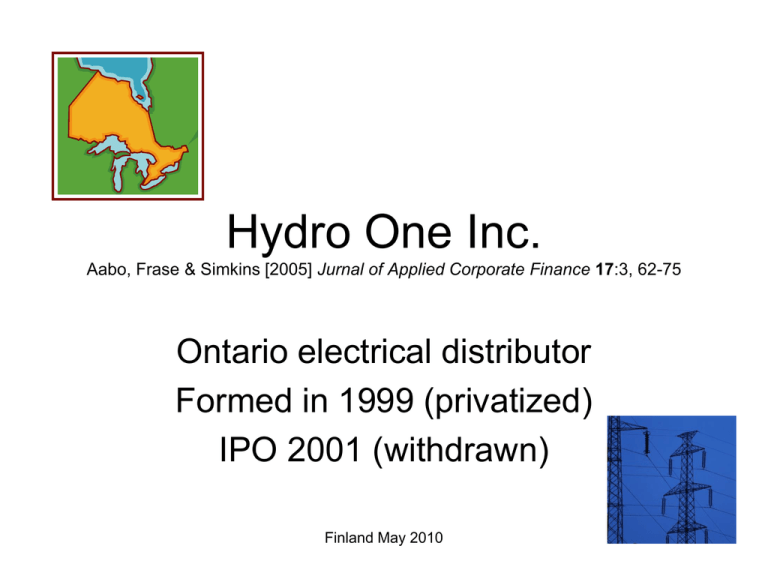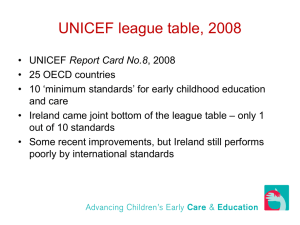Hydro One Inc.
advertisement

Hydro One Inc. Aabo, Frase & Simkins [2005] Jurnal of Applied Corporate Finance 17:3, 62-75 Ontario electrical distributor Formed in 1999 (privatized) IPO 2001 (withdrawn) Finland May 2010 ERM at Hydro One • Late 1999 head of Internal Audit appointed CRO • Corporate Risk Management Group established – CRO, 2 full-time professionals – Given 6 months to prove themselves – Early 2000 prepared • ERM Policy • ERM Framework Finland May 2010 ERM Policy • Audit & Finance Committee of the Board – • President – • specific accountabilities for managing risks in their subsidiary or function each will establish specific risk tolerances for their lines of business that do not exceed the limits of corporate risk tolerances expected to annually formally attest that the unit’s risk management process is in place, operating effectively and is consistent with this policy. Line and Functional Managers – – • provides management oversight of the Hydro One risk portfolio and the Corporation’s risk management processes provides direction on the evaluation of these processes identifies priority areas of focus for risk assessment and mitigation planning Each of the President’s Direct Reports – – – • specific accountability for ensuring that enterprise risk management processes are established, properly documented and maintained Senior Management Team – – – • ultimate accountability for managing the Corporation’s risks Chief Financial Officer – • Annually reviews the Corporation’s risk profile, the risk retention philosophy/risk tolerances of the Corporation, and the risk management policies, processes and accountabilities responsible for managing risks within the scope of their authority and accountability risk acceptance or mitigation decisions made explicitly and within the risk tolerances specified by the head of the subsidiary or function Chief Risk Officer – – provides support to the President, CFO, Senior Management Team and key managers within the corporation includes developing risk management policies, frameworks and processes, introducing and promoting new techniques, preparing annual corporate risk profiles, maintaining a registry of key business risks, and facilitating risk assessments across the Corporation Finland May 2010 Risk Definitions from Risk Policy • Risk: – potential that an event, action or inaction will threaten Hydro One’s ability to achieve its business objectives. Risk is described in terms of its likelihood of occurrence and potential impact or magnitude. Broad categories of risk in Hydro One include strategic, financial, and operational risks. • Risk Assessment: – systematic identification and measurement of business risks on a project, line of business or corporate basis. It also includes the review or establishment of risk tolerances, the evaluation of existing mitigation controls and conscious acceptance or treatment of residual risk. • Risk Mitigation/Treatment: – Actions or decisions by management that will change the status of a risk. Options include • • • • • • retaining the risk (either completely or partially), increasing the risk (where mitigation is not cost-effective), avoiding the risk (by withdrawing from or ceasing the activity), reducing the likelihood (by increasing preventive controls), reducing the consequences (by emergency or crisis response), and/or transferring the risk (by outsourcing, insurance, etc.). Finland May 2010 Risk Definitions From Risk Policy • Risk Profile: – results of any risk assessment, assembled into a consolidated view of the significant strategic, regulatory, financial and operational risks at play in a project, line of business or across the Corporation. • Risk Tolerances: – Guidelines first establish levels of acceptable and unacceptable exposure from any risk. – Tolerances define the range of possible impacts (from minor to catastrophic) that risks might have on business objectives. – Risk tolerances are established for the Corporation and reviewed annually. – Each project, function or line of business assessing its risks is expected to use or develop a set of risk tolerances that does not exceed established corporate limits. Finland May 2010 Risk Management Process • Establish Business Context • Identify Risks – What can happen?/How? • Assess Risks & Controls – Determine consequence • Assess Current Controls – – – – Confirm existence/Determine effectiveness Estimate strength of controls Determine likelihood Estimate level of risk • Check if Risk is Tolerable – If not, Mitigate/Treat Risks Finland May 2010 Dimensions of Likelihood 5 – Virtually certain 0.95 probability will occur within 5 years 4 – Very likely 0.75 probability will occur within 5 years 3 – Even odds 0.50 probability will occur within 5 years 2 – Unlikely 0.25 probability will occur within 5 years 1 – Remote 0.05 probability will occur within 5 years Finland May 2010 Risk Magnitude 1. Minor • 2. 3. 4. 5. few controls needed Moderate Major Severe Worst case • full prescriptive controls with executive oversight Finland May 2010 Means of Dealing with Risk • Retain – risk exposure accepted without mitigation, since potential return is viewed as desirable and downside exposure is not significant; • Retain but change mitigation – • a partially mitigated exposure is maintained, but change in mitigation reduces the cost of control; Increase – risk exposure is increased, either because the potential return is viewed as desirable or the controls in place are not cost effective; • Avoid – risk exposure to be entirely eliminated, possibly by withdrawal from a business area, since the potential return does not offset downside exposure; • Reduce the likelihood – risk exposure reduced cost-effectively through new or enhanced preventive controls; • Reduce the consequences – impact of any risk that materializes will be reduced through emergency preparedness or crisis response; Finland May 2010 Hydro One Risk Tolerances 3 of 16 total Financial Reputation 1 Minor <$5M loss Letter to Govt, <1000 mgmt <10MW 2 Moderate $5-25M Local 3 Major $25-75M Provincial 4 Severe $75-150M National 5 Worst >$150M International Finland May 2010 Reliability 1-10k 10-100MW 10-40k 100-400MW 40-100k 400-1k MW >100k >1MW Pilot Study • Spring 2000 workshop • One subsidiary • Pre-meeting – e-mailed participants – Asked for list of 10 most critical risks – Compiled, top eight selected • Delphi • Vote on 1-5 scale • Discuss – Iterate • Deemed successful – ERM continued Finland May 2010 Corporate Risk Profile Risk source Trend Mitigation Growth Very high, up Senior mgmt participation in govt Regulatory Very high, up Org. Readiness High, up More board participation; Add regulatory staff Contracting, labor rel., technology Network subs. High, new Finland May 2010 Strategy & transition plan Corporate Risk Profile Risk source Trend Mitigation Asset condition High, even Redundancy, emergency response Catastrophic events High, down Planning, forecasting, insurance Environmental Contamination High, even Hazardous operations Medium, up Design, maintenance, training, supervision Insurance Finland May 2010 Corporate Risk Profile Risk source Trend Mitigation Market ready project Medium, even Delay market entry New electricity marketplace Medium, even Participate on market board, negotiate Economy/ financial markets Medium, down Limit floating rate debt, interest rate swaps, diversified customer base Finland May 2010 Benefits of ERM • Lower debt cost: – • Capital expenditures focused on greatest risk mitigation per investment: – • Board of Directors was initially skeptical now routinely expects risk analysis Implement formalized risk management system: – • ERM workshops aided the executive team to articulate risks faced Many other examples of stakeholder reassurance existed. Improve corporate governance: – – • dismissal of the Board of Directors and reaction to the oil spill. Reassurance to stakeholders that the business is well managed: – – • the risk-based structural approach yielded an optimal portfolio of capital investments Catastrophe avoidance: – • Initial debt issue was oversubscribed about 50 percent, and ERM was credited by ratings analysts as being a significant factor in high ratings received Formalized system drives periodic assessment, documentation, and risk reporting Identify risks where Hydro One is most competitive: – – A subsidiary involved in marketing electricity was sold due to high commodity risks several processing and administrative functions were outsourced to transfer labor union and cost risks Finland May 2010








